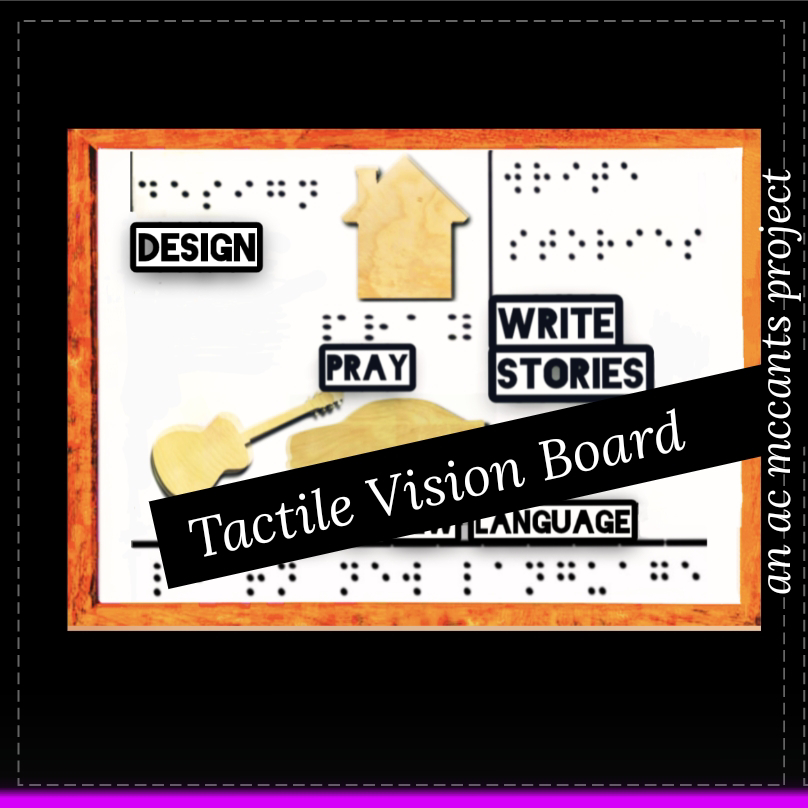The Tactile Vision Board and The Tactile Vision Book are perceived by touch.
The images for the Tactile Vision Board can be posted on a magnetic board or a poster board and can be secured with adhesive strips or adhesive magnetic strips.
The images for the Tactile Vision Book can be posted in a book with cardstock, poster board or plastic pages. And secured with adhesive strips.
The images for the Tactile Vision Board and The Tactile Vision Book could come from pre-cut shapes from wood or cardboard or plastic.
The shapes could be a car, a house, a guitar and so forth. Raised words or braille text could also be used.
WHAT IS A VISION BOARD?
A Vision Board is a collage of images and words representing your dreams and goals.
It serves as a reminder for you to stay focused on what you want in life.
DO NOT CLUTTER YOUR VISION BOARD
A cluttered vision board makes it harder for you to focus on your goals consciously and subconsciously.
You could post your vision board or vision book where you would come in contact with it on a regular basis.
For what you want to remain private, label it private. Just remember what it is.
Before Making a Vision Board or a Vision Book,
create a list of:
*What you want to Do
*What you want to Have
•What you want to Give
and...
*How you want your life to Be
You do not have to know how everything is going to fall into place. Just be clear about what you truly desire.
When you are clear about what you want in life, ideas and opportunities come to you to help make your dreams come true.
THE STORY BEHIND THE VISION BOARD for THE BLIND
A.C. McCants was inspired to create a vision board for the blind because of her admiration for Jeanette Cade, who was a real estate broker that some believed to be completely blind.
One evening, during a discussion about careers, Cade realized McCants enjoyed designing posters to help others attract attendees to their events.
Cade suggested McCants go to school for graphic designing. She wanted McCants to have a career in doing something she enjoyed doing.
A few weeks later, Jeanette Cade passed away.
When McCants looked at her vision board again, the idea of a vision board for the blind came to mind. She researched names for raised words and images and found the word TACTILE.
The word TACTILE was the perfect word for McCants to use in her title for her vision board project for the blind. She called her project The Tactile Vision Board.
Throughout the years, McCants would revise her Tactile Vision Board Project.
One day, McCants came across an article: The Tactile Picture Books Project by Tom Yeh. That particular article gave McCants the idea to create The Tactile Vision Book for The Blind and The Visually Impaired.
Again and again, McCants continued to revise her Tactile Vision Board and Tactile Vision Book Project until one day she discovered an article online: Can You Create a Vision Board with No Vision? This article was written by Empish J. Thomas, who is blind.
With the help of a friend, Thomas created a tactual vision board to help her accomplish a specific goal.
McCants finally decided it was time to stop revising her Vision Board Project for The Blind and post it online along with helpful tips for creating one.
A Short Story and Poem by ac mccants…
THE BLIND LADY WANTED ME TO DESIGN
THE DEAF LADY WANTED ME TO SING
Jeanette Cade
was a real estate broker
Whom some believed to be
completely blind
It was hard for me to tell
She seemed to be looking at me
from time to time
I gave her a poster I created
To help promote her company
She held my design upside down
Yet her compliment, I did BELIEVE
One day she said to me
For graphic designing
You should go to school
Designing is something
It seems you love to do
I was looking to help her
But she actually helped me
Gone But Not Forgotten
As She Rest in Peace
Somewhere in time, some of my co-workers and I formed a band so we could perform at our outdoor event.
It was a thrill for me to be on stage singing background as well as solo.
When we were done performing, one of the ladies (from the company) came up to me and said "Child you miss yo callin'."
Later that day or maybe the next, a lady named Shirley (from a department I once worked in) passed me a letter she had written on scrap paper.
Shirley could not hear me because she was deaf. When I read her letter I could tell she believed it was my destiny to be a performing artist. And a part of me believed it as well.
I always thought about Shirley’s letter, and hoped someday we would reconnect.
Shirley could not hear me
But believed performing was my destiny
I can’t remember her last name
But I think about her just the same
ABOUT THE AUTHOR:
A.C. McCants writes short stories, song lyrics, ideas and more to enrich the lives of others.
McCants created The Tactile Vision Board and The Tactile Vision Book Project for the purpose of igniting ideas for a vision board project for The Blind and The Visually Impaired.

